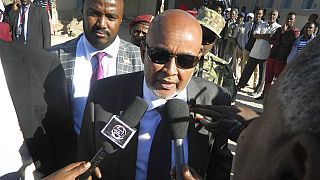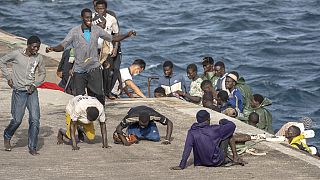Somalia
Flash flooding from heavy rains killed dozens and affected 300,000 people in Ethiopia and Somalia in March 2023. The damaging flooding came after the region has experienced almost three years of extreme drought.
In the first 25 days of March, parts of Ethiopia received 5 to 10 centimeters (2 to 4 inches) more rain than is usual for the period, according to a report from Crop Monitor.
“Normally, the long rains begin in Kenya and move north to Ethiopia and Somalia,” said Caroline Wainwright, a climate scientist at Cardiff University in the United Kingdom. “But this year, the rains started concurrently, and the last two weeks of March were incredibly wet in all three countries.”
Moderate to heavy rains in the Ethiopian highlands overtopped banks of the Shabelle and Juba rivers. Homes, schools, and health facilities were destroyed along the banks of the two rivers, in southern Somalia and eastern Ethiopia, according to the United Nations Office for the Coordination of Humanitarian Affairs (UN OCHA).
Flooding along the Shabelle River in the Somali region of Ethiopia can be seen in the image (right) above, acquired by the Moderate Resolution Imaging Spectroradiometer (MODIS) on NASA’s Terra satellite.
The Horn of Africa has seen almost three years of some of worst drought conditions in history. Ethiopia and Somalia have had five failed rainy seasons since late 2020, which have displaced 1.4 million Somalis and killed 3.8 million livestock.
During this time the Shabelle-Juba river basins saw their lowest rainfall totals since 1981.
“This flooding doesn’t just undo three years of drought,” Wainwright said. Her recent research into the drivers and impacts of rainfall variability in East Africa found that from the mid-1980s to 2010, the long rains have been getting drier. In fact, the research team’s analysis of climate projections found that the short rains could deliver more rainfall than the long rains by 2030–2040.
More than 1,000 hectares of cropland have been swamped by recent rains, challenging the agricultural economies in Ethiopia and Somalia. Agriculture employs 67 and 80 percent of people in these countries, respectively, and much of the farmland in the region is rain-fed. Although rainfall can provide some relief, intense rainfall following extensive drought can wash away crops and topsoil. Most of the farms in the area also lack the infrastructure to store water for future use.
Even with the unexpectedly early and heavy rains in March, climate models project that the long rains this year will be drier than normal and drought conditions are likely to continue.












01:11
Climate crisis takes centre stage at G20 summit in Brazil
01:38
COP29: What next for Africa's energy transition?
01:00
Somaliland counts votes after pivotal election
01:26
Zimbabwe’s Climate-Smart Agriculture: Empowering Farmers through Resilience and Innovation
01:14
Delegates express cautious optimism on second day of climate summit
01:14
Afghanistan’s delegation attends COP29, seeks international backing for climate action